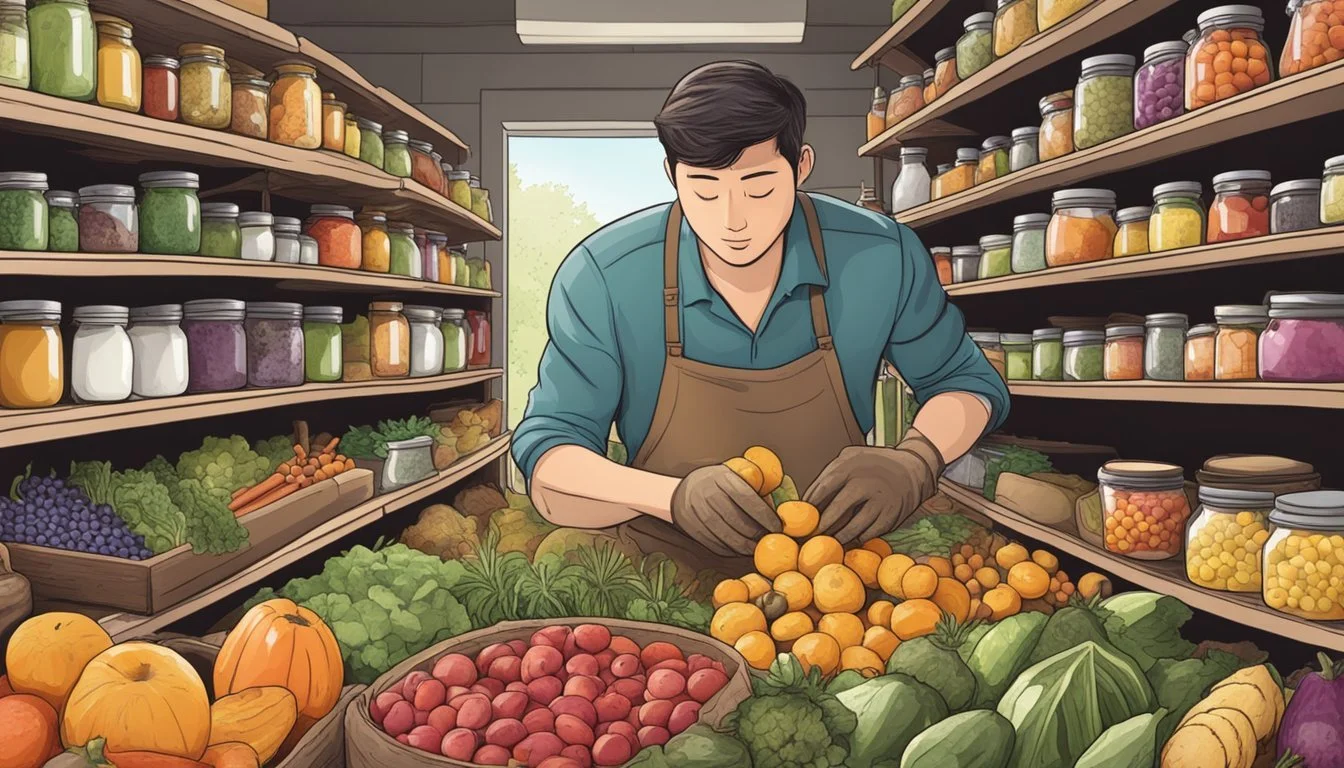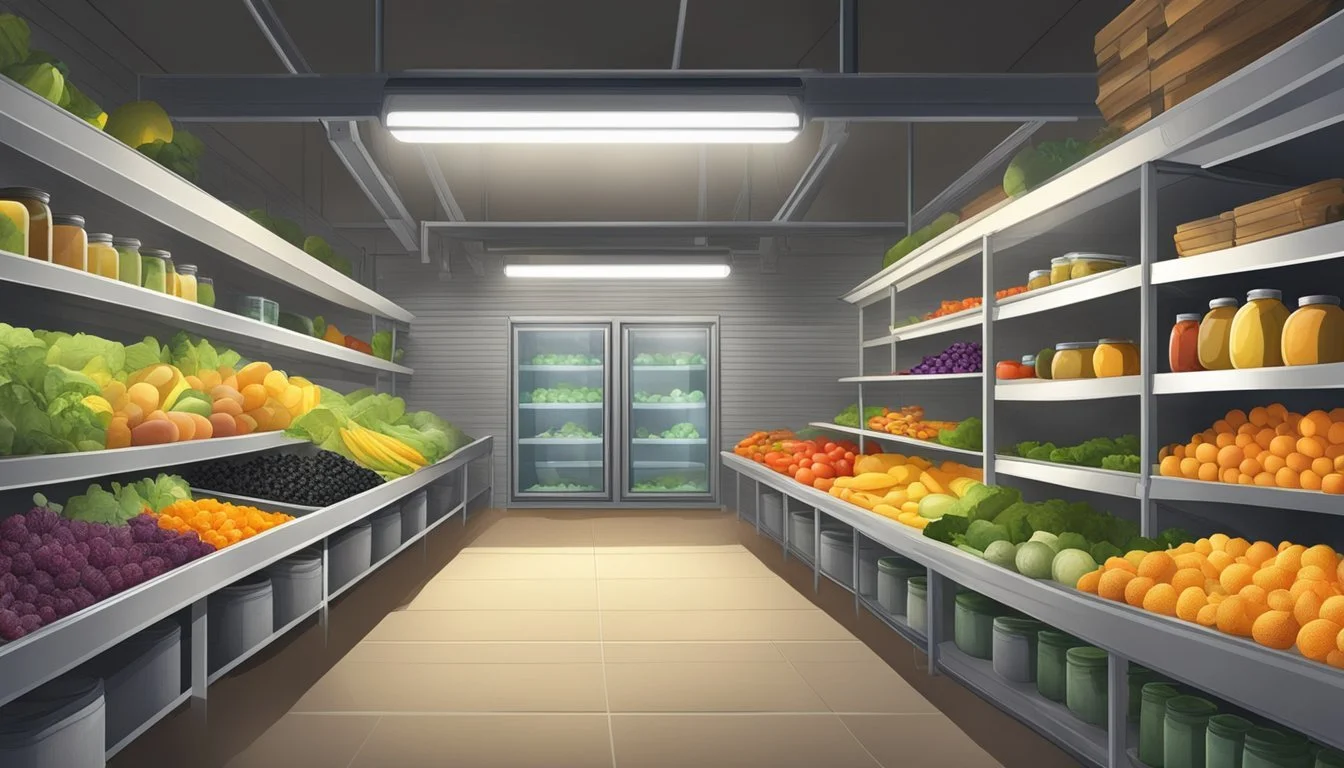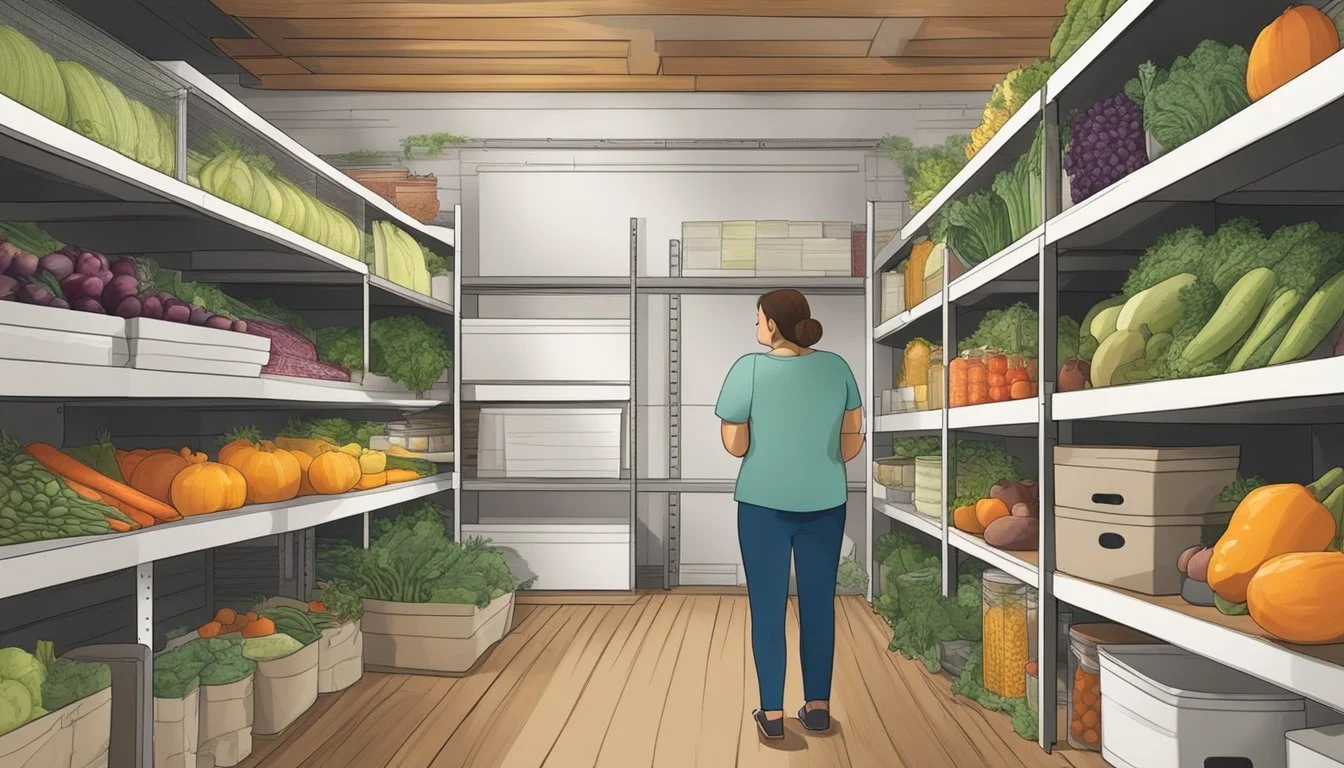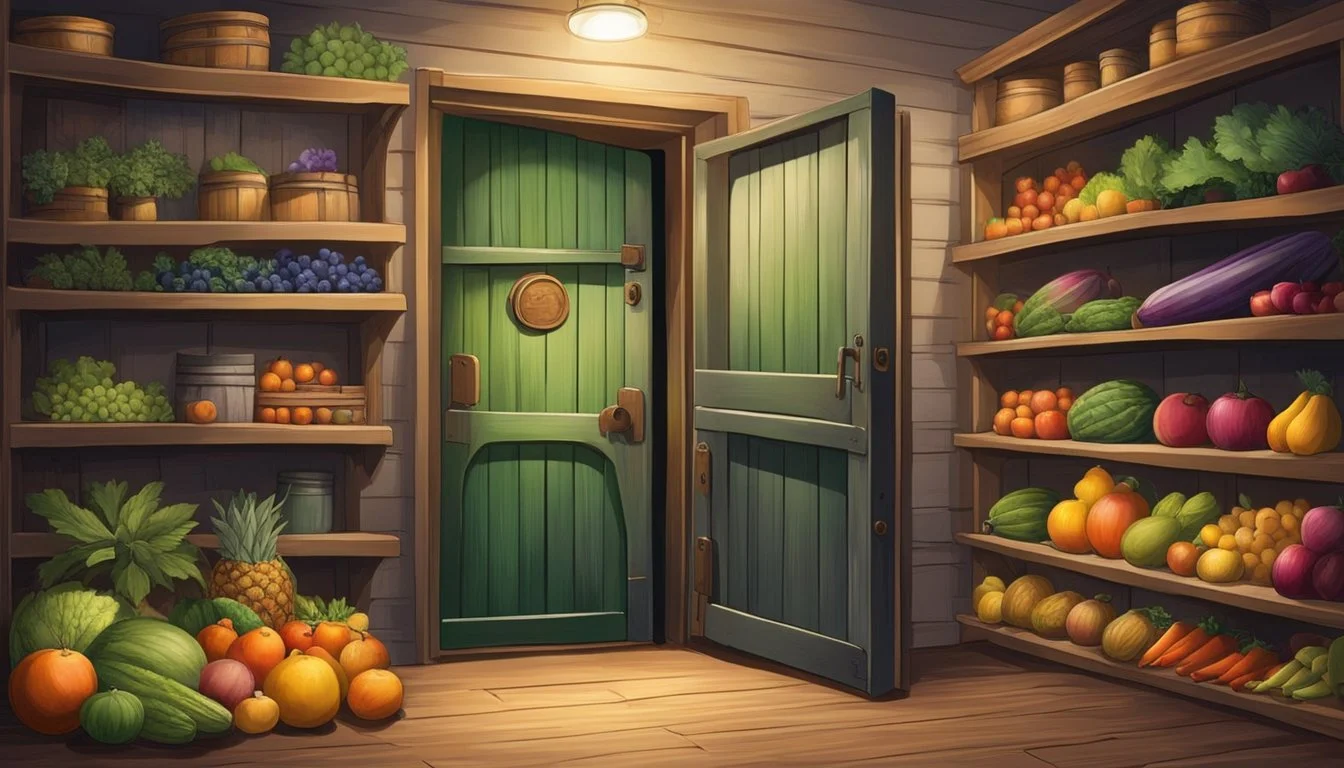The Ultimate Guide to Building a Root Cellar
Storing Your Harvest with Confidence
A root cellar embodies a time-tested method for food preservation, providing an ideal environment for extending the shelf life of homegrown produce. Traditionally, root cellars have been used to store fruits, vegetables, nuts, and other foodstuffs over the cold winter months. With the increasing interest in self-sufficiency and organic produce, building a root cellar is becoming more of a consideration for modern gardeners and homesteaders. By maintaining a consistently cool temperature and proper humidity levels, a root cellar can preserve food without the need for electricity, making it both an eco-friendly and cost-effective solution.
The process of constructing a root cellar requires careful planning and consideration of various factors such as location, temperature, humidity, and ventilation. Ideally, a root cellar is partially or entirely underground to take advantage of the earth’s natural insulation. Proper ventilation is critical to managing temperature and preventing the buildup of ethylene gas, which can cause produce to spoil more rapidly. Insulation and organization within the cellar are also key elements that contribute to creating an optimal environment for preserving a wide range of homegrown fruits and vegetables.
Upon successful construction, a root cellar serves as a valuable asset for any gardener or homesteader, enabling them to enjoy the fruits of their labor throughout the year. The cellar's ability to preserve food naturally aligns with the goals of those seeking to reduce waste, save money, and enhance the quality of their diet with homegrown produce. Armed with the right knowledge and tools, building a root cellar is a project that rewards with sustainability and self-reliance.
Planning Your Root Cellar
When embarking on building a root cellar, it's crucial to carefully plan its location, size, and design to ensure a proper storage environment for harvested produce. Selecting appropriate building materials is equally essential for the structural integrity and insulation of the cellar.
Choosing the Right Location
The ideal site for a root cellar is partially or fully underground to utilize the Earth's natural insulation. It's important to consider factors like drainage, to prevent water pooling, and ease of access during winter. The chosen location should maintain a consistent temperature and high humidity, both vital for preserving produce.
Drainage: Ensure site has good natural drainage
Consistent Temperature: Choose a shaded spot
Accessibility: Plan for year-round access
Determining the Size and Design
The size of your root cellar should align with your storage needs while considering available space and the type of produce you plan to store. Common dimensions for a small to medium cellar range from 8x10 feet to 10x15 feet. The design should include features like shelved storage and proper ventilation to manage humidity and temperature.
Storage Needs: Match cellar size to the quantity of produce
Ventilation: Include features for air circulation
Shelving: Plan for adjustable and durable shelving
Selecting Building Materials
The choice of building materials impacts the cellar's durability and effectiveness. An effective root cellar should be constructed with materials that support proper insulation and can withstand the underground environment.
Insulation: Use materials like wood or insulated concrete forms
Durability: Consider metal or treated wood for structural support
Roof: A concrete slab is often recommended for longevity and strength
In summary, each aspect of planning from location to building materials is a vital step in creating an effective root cellar. Precision in these initial stages lays the groundwork for achieving the desired outcome – a functional space for preserving your harvested produce.
Building the Foundations
Building a sturdy foundation for a root cellar is crucial for its longevity and effectiveness. The process involves site excavation, laying a solid foundation, and constructing the robust walls and ceiling necessary for underground storage.
Excavating the Site
The excavation must be planned carefully to ensure the appropriate depth and width while considering soil conditions. One begins by marking out the desired area, typically ensuring that the space is larger than the finished cellar to accommodate construction movements. They should remove the topsoil and dig down to the prescribed depth, ensuring that the walls of the excavation are stable to prevent any collapses.
Key considerations:
Depth: Typically 8-10 feet below ground to leverage the earth's natural insulation.
Soil Assessment: Assessing the soil type for drainage capabilities to prevent water accumulation around the cellar.
Laying the Foundation
A strong foundation is critical in preventing moisture damage and maintaining a consistent internal temperature. After excavation, they lay a foundation, often a concrete slab, which serves as the cellar's floor and structural base. The concrete slab should be thick and reinforced to support the walls and ceiling while sealing out moisture.
Concrete Slab Specifications:
Thickness: At least 4 inches, often reinforced with a wire mesh or rebar.
Waterproofing: Apply a waterproof membrane or coating to prevent water ingress.
Constructing the Walls and Ceiling
The walls are constructed on the foundation, typically using blocks or poured concrete to ensure adequate support for the earth outside and the ceiling above. Insulation is crucial in maintaining the internal environment of the cellar. The construction of the ceiling must support any weight from above and withstand environmental pressures.
Materials and Methods:
Walls: Cinder blocks, poured concrete, or stone.
Insulation: Materials such as polystyrene boards to insulate the walls.
Ceiling: Poured concrete slab or precast concrete panels for strength and durability.
Environmental Control Features
The effectiveness of a root cellar as a storage space predominantly hinges on its ability to maintain a cool, consistent temperature, regulate humidity, and ensure adequate ventilation.
Maintaining Optimal Temperature
A root cellar's primary function is to provide a cool environment for the produce. The optimal temperature range is typically slightly above freezing, between 32-39°F (0-4°C). Thermometers are vital for monitoring the cellar temperature. To maintain this cool temperature, insulation plays a critical role by reducing unwanted heat transfer from the outside. Additionally, the underground room takes advantage of the earth's natural insulation, which helps keep the temperature stable.
Regulating Humidity
High humidity levels are essential for moisture control, and most root cellars will aim for humidity above 80%. Measuring humidity can be efficiently done with a hygrometer. To prevent the dehydration of stored produce and preserve its freshness, moisture levels must be controlled. Materials such as straw or sawdust can be used to help retain moisture within the space.
Ensuring Proper Ventilation
Proper ventilation is imperative for an effective storage space. It helps to regulate both temperature and humidity, thus preventing the accumulation of ethylene gas which can hasten produce spoilage. A sound ventilation system will allow fresh air to circulate and stale air to exit. This can be achieved through strategically placed vents: one close to the floor for cool air intake and another near the ceiling to allow warm air to escape.
Interior Setup and Storage Solutions
In building a functional root cellar, careful attention must be paid to the interior design, focusing on shelving and climate control, to ensure the extended shelf life of harvested produce.
Designing the Layout and Shelves
The interior design of a root cellar should be planned to maximize space and accessibility. Shelving is integral to this design, as it facilitates organization and proper air circulation around stored produce. To achieve this, sturdy shelves made of materials resistant to moisture, such as treated wood or metal wire, should be installed. A typical shelving layout includes:
Horizontal Shelves: Arranged at varying heights to accommodate different sizes of produce.
Vertical Spacing: At least 3 inches between shelves to promote airflow.
Shelves should also be adjustable for flexibility and designed to bear the weight of heavy root vegetables like potatoes and beets.
Optimizing Storage Conditions for Produce
The key to prolonging the shelf life of vegetables in a root cellar is maintaining optimal storage conditions:
Temperature: Keep the root cellar just above freezing (32-39°F/-0 to 4°C).
Humidity: Maintain humidity levels above 80% to prevent dehydration of vegetables.
Darkness: Ensure the interior remains dark to inhibit the growth of sprouts on tubers.
Ventilation: Use ventilation to regulate humidity and temperature, as well as to prevent the buildup of ethylene gas, which can hasten spoilage.
Each type of vegetable may require specific storage tips. For instance, root vegetables thrive in high moisture and cool temperatures, whereas onions and garlic prefer lower humidity. Utilizing mesh bags or slatted crates can improve air circulation, and separating ethylene-producing items from those sensitive to the gas minimizes spoilage.
Preserving Different Types of Harvested Produce
Effective storage of harvested produce extends its shelf life and maintains quality. The type of produce dictates the specific preserving techniques, ensuring flavors and nutrients are retained for longer periods.
Storing Root Vegetables and Tubers
Root vegetables and tubers such as potatoes, turnips, beets, and carrots thrive in cool, humid conditions, usually between 32°F and 40°F with 95% humidity. The traditional root cellar or a similar storage space meets these conditions. Store them in neatly stacked boxes or bins, using materials like damp sand or peat moss to prevent them from touching each other, which minimizes decay and maintains freshness.
Potatoes: Keep in a dark place to prevent greening.
Turnips/Beets: Remove tops, leaving about an inch of the stem.
Carrots: Can be left in the ground with a thick mulch layer until needed if outside conditions permit.
Handling Fruits and Squash
Fruits such as apples and vegetables like pumpkins and squash require slightly different treatment due to their nature. They generally need a slightly warmer storage temperature range — from 40°F to 50°F with moderate humidity.
Apples: Ideally, store apples separated from other produce to prevent ethylene gas from accelerating ripening.
Pumpkins/Squash: Cure for a week in a warm place before storage. Then, keep in a single layer, not touching, on shelves or racks.
Keeping Green Vegetables Fresh
Leafy greens, cabbage, and lettuce are more perishable and require storage that can maintain their freshness.
Leafy Greens: Store in a root cellar in breathable containers, such as baskets, that allow for air movement.
Cabbage: It is hearty and can last for months when stored on a shelf in a cool, humid environment.
Lettuce: Keep in moist, but not wet, conditions utilizing perforated plastic bags to retain humidity without causing rot.
Maintenance and Upkeep
Maintaining a root cellar requires diligence to preserve the quality of stored food and to minimize waste. Proper cleaning, temperature and humidity control, and pest management are crucial for a functional cellar.
Regular Cleaning and Maintenance
It is imperative to regularly clean the root cellar to prevent mold and mildew, which can lead to food spoilage. This includes:
Sweeping floors to remove debris.
Inspecting the walls and ceiling for signs of dampness or fungal growth.
Wiping down shelves with a mild bleach solution to sanitize surfaces.
Cleaning should occur at least once at the end of the storage season before new produce is added.
Monitoring Temperature and Humidity
For optimal preservation of produce, a root cellar should maintain:
A consistent temperature just above freezing, between 32-39°F.
A humidity level above 80%.
Tools such as a hygrometer to measure humidity and a thermometer for temperature are essential. Regular checks ensure the environment remains within these parameters to prevent spoilage and extend the shelf life of vegetables and fruits.
Managing Spoilage and Pest Control
To minimize food waste:
Remove spoiled produce immediately to prevent the spread of decay to other stored items.
Implement pest control measures by sealing any entry points and using traps if necessary.
Effectively managing spoilage and pests safeguards the longevity of the root cellar's contents and helps to preserve food quality.
Additional Uses and Benefits of a Root Cellar
Root cellars serve not only as efficient storage solutions for homegrown produce but also offer multifunctional benefits that extend well beyond food preservation.
Extending the Shelf Life of Homegrown Produce
Root cellars provide an ideal environment for extending the shelf life of fruits and vegetables. The cool, humid conditions are perfect for slowing down the ripening process, allowing produce such as apples, potatoes, and root vegetables to last for much longer periods than they would at room temperature. By maintaining a temperature just above freezing and a high humidity level, a root cellar can keep homegrown produce fresh for months.
Utilizing Root Cellars for Year-Round Storage
A root cellar is an excellent storage solution for year-round use. Not limited to just fall harvests, they can be used to store a variety of foods including canned goods, beverages, and other non-perishable items. The underground nature of root cellars means the temperature remains relatively constant, providing year-round storage without the costs associated with electrical cooling appliances.
Creating a Dual-Purpose Storm Shelter
The robust structure of a root cellar, typically located underground, can also serve as a safe haven during severe weather events. By design, root cellars have the capacity to be dual-purpose, doubling as a storm shelter. The insulated and buried walls offer not only excellent food preservation conditions but also a degree of safety for individuals during unexpected weather crises. This multifunctionality makes root cellars a practical addition to homes in regions prone to such events.
Advanced Root Cellar Features
When building a root cellar, implementing advanced features can significantly improve the storage environment for preserving harvested produce. These features enhance environmental control, leading to better preservation of fruits and vegetables.
Automating Temperature and Ventilation Systems
Temperature Control: An automated temperature system is key for maintaining an optimal climate within the root cellar. Utilizing thermostats connected to ventilation fans, the system can detect when the temperature deviates from the ideal range—typically between 32 to 40°F (0 to 4°C)—and activate the fans accordingly.
Automated Ventilation: A ventilation system includes motorized dampers controlled by a hygrostat or humidistat.
Fan Installation: Strategically placed fans help in distributing the cool air evenly throughout the space.
Incorporating Moisture Control Solutions
Moisture Control: Achieving the right balance of humidity—around 85 to 90%—is crucial. Hygrostats or humidistats can automate moisture level control to prevent the cellar from becoming too damp or too dry.
Drainage Solutions: Proper drainage ensures that any excess moisture is quickly removed from the cellar, with the optimal soil grading and weeping tiles installation.
Vapor Barriers: These barriers help to contain the moisture within the desired areas, preventing the build-up of condensation.
Enhancing Insulation and Energy Efficiency
Insulation: Using high-quality, water-resistant insulation materials is essential for maintaining consistent internal temperatures and reducing energy use.
Materials: Options such as closed-cell foam insulation provide barriers against heat and cold.
Energy Efficiency: By ensuring that the cellar is well-insulated, energy consumption can be minimized, as the underground structure will naturally maintain stable temperatures.
Incorporating these advanced features into root cellar design will significantly contribute to creating a stable environment that extends the shelf life and quality of harvested produce through meticulous environmental control.
Cost Estimation and Budgeting
Building a root cellar is an investment into a homeowner's long-term storage solution for preserving produce. The cost varies widely depending on factors such as size, location, materials, and whether a contractor is hired or if it is a DIY project.
Project Scope & Size Settling on the root cellar's size is the first step. Homeowners should assess their storage needs based on the quantity of produce they aim to store. The bigger the cellar, the higher the cost.
Small: Up to $3,000
Medium: Between $3,000 - $7,000
Large: Can exceed $10,000
Materials The choice of materials affects both the functionality and the cost. Common materials include wood for framing, concrete for walls and floors, and insulation materials.
Timber: Economical but less durable
Concrete: More expensive, increased longevity
Insulation: Essential for temperature control, varying in price
Labor vs. DIY Contractor labor adds significantly to the cost; however, it ensures professional quality and efficiency. For those with construction experience, a DIY approach can be cost-effective.
Contractor: Higher costs, professional finish
DIY: Lower upfront costs, requires more time and skill
Budgeting A detailed budget should account for:
Materials: $500 - $5,000+
Labor: $2,000 - $6,500
Miscellaneous: Ventilation, shelving, etc.
Homeowners should also consider additional costs such as permits, tools, and contingency for unexpected expenses. It's advisable to overestimate costs by at least 10-15% to safeguard against budget overruns.
DIY Root Cellar Plans and Construction Tips
When constructing a DIY root cellar, individuals should first plan the layout and size according to their needs. A typical size for a small household root cellar might be 6x8 feet, but size may vary based on storage needs and available space.
Materials play a pivotal role. Imperative to consider are:
Insulation: Use materials such as straw bales or rigid foam to insulate walls not in contact with the soil.
Walls: Concrete blocks or poured concrete are suitable for structural support.
Flooring: Earth, gravel, or concrete can be used, with earth or gravel helping to regulate humidity levels.
A proper construction approach includes:
Excavation: Carefully dig the chosen area while ensuring the surrounding landscape's integrity.
Ventilation: Implement a ventilation system using PVC pipes or other materials to manage airflow and maintain optimal humidity, typically between 90 to 95 percent.
Roofing: A reinforced concrete slab offers durability, but treated wood alternatives could suffice for smaller cellars.
Tips:
Ensure the entrance is well-sealed to maintain internal conditions.
Position the root cellar in a location that naturally benefits from earth's insulating properties.
For indoor cellars against a basement, insulation should prevent warmth from the house affecting the cooler storage climate.
The above provides foundational guidance for building an efficient root cellar, combining durability with an effective preservation environment for produce.
Root Cellar Safety and Regulations
When building a root cellar, one's safety and adherence to regulations should take precedence. The process involves understanding structural integrity, ventilation requirements, and local building codes to ensure a secure and functional space for preserving produce.
Structural Considerations:
Support: Walls and roofing must withstand soil pressure and potential aboveground weight. Consider concrete, cinder block, or reinforced structures and consult an engineer.
Door Safety: The entrance should be robust, with secure hinges to prevent accidents.
Ventilation Concerns:
Humidity Control: Adequate ventilation is necessary to manage humidity and prevent spoilage.
Gas Escapement: Proper airflow allows ethylene gas, which can hasten ripening, to escape.
Building Regulations:
Permits: One may require a permit; always check with local authorities.
Guidelines: Adhere to local building codes, which may dictate specifications for egress, foundation, and waterproofing.
Maintenance:
Regular inspections are crucial to ensure safety standards are maintained over time.
Safety Tips:
Steer clear of using hazardous chemicals in construction materials.
Install a carbon monoxide detector, as root cellars can be airtight.
Utilize safe, mold-resistant paints and sealants.
Accessibility:
Keep clear access for emergency situations; ensure the pathway in and out of the cellar is always unobstructed.
Understanding and respecting the balance between age-old practices and modern regulations is key for a successful and safe root cellar. Through diligent attention to safety and regulations, one can enjoy the benefits of a well-preserved harvest.
Frequently Asked Questions
What temperature should be maintained in a root cellar?
Root cellars function best at temperatures between 32°F and 40°F. This range is ideal for slowing down the produce's respiration and decay processes.
How important is humidity in a root cellar?
Maintaining a high humidity level, around 90 to 95 percent, is crucial. It prevents dehydration and wilting of stored produce. However, it should not be so high as to cause condensation and mold growth.
What type of ventilation is required?
Proper ventilation helps regulate temperature and humidity, and it removes ethylene gas released by stored produce. A balance should be struck to ensure fresh air can circulate without raising the internal temperature.
Can all types of produce be stored in a root cellar?
Not all produce benefits from root cellar storage. It is best suited for root vegetables, tubers, and hardy fruits. These items are less prone to rot and can take advantage of the cool, moist environment.
What is the best way to organize stored items?
Organize produce by type and maturity. Use shelving units, bins, or racks to separate different items and allow for air circulation. Monitor regularly to remove any spoiled items and prevent them from affecting the rest.








